跨文化作业5
- 格式:doc
- 大小:52.50 KB
- 文档页数:3
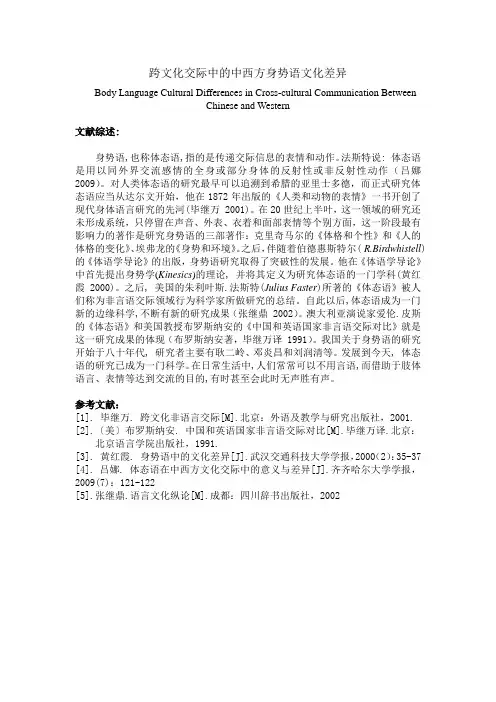
跨文化交际中的中西方身势语文化差异Body Language Cultural Differences in Cross-cultural Communication BetweenChinese and Western文献综述:身势语,也称体态语,指的是传递交际信息的表情和动作。
法斯特说: 体态语是用以同外界交流感情的全身或部分身体的反射性或非反射性动作(吕娜2009)。
对人类体态语的研究最早可以追溯到希腊的亚里士多德,而正式研究体态语应当从达尔文开始,他在1872年出版的《人类和动物的表情》一书开创了现代身体语言研究的先河(毕继万 2001)。
在20世纪上半叶,这一领域的研究还未形成系统,只停留在声音、外表、衣着和面部表情等个别方面,这一阶段最有影响力的著作是研究身势语的三部著作:克里奇马尔的《体格和个性》和《人的体格的变化》、埃弗龙的《身势和环境》。
之后,伴随着伯德惠斯特尔( R.Birdwhistell)的《体语学导论》的出版,身势语研究取得了突破性的发展。
他在《体语学导论》中首先提出身势学(Kinesics)的理论, 并将其定义为研究体态语的一门学科(黄红霞 2000)。
之后, 美国的朱利叶斯.法斯特(Julius Faster)所著的《体态语》被人们称为非言语交际领域行为科学家所做研究的总结。
自此以后,体态语成为一门新的边缘科学,不断有新的研究成果(张继鼎 2002)。
澳大利亚演说家爱伦.皮斯的《体态语》和美国教授布罗斯纳安的《中国和英语国家非言语交际对比》就是这一研究成果的体现(布罗斯纳安著,毕继万译 1991)。
我国关于身势语的研究开始于八十年代, 研究者主要有耿二岭、邓炎昌和刘润清等。
发展到今天, 体态语的研究已成为一门科学。
在日常生活中,人们常常可以不用言语,而借助于肢体语言、表情等达到交流的目的,有时甚至会此时无声胜有声。
参考文献:[1]. 毕继万. 跨文化非语言交际[M].北京:外语及教学与研究出版社,2001.[2].〔美〕布罗斯纳安.中国和英语国家非言语交际对比[M].毕继万译.北京:北京语言学院出版社,1991.[3]. 黄红霞. 身势语中的文化差异[J].武汉交通科技大学学报,2000(2):35-37[4].吕娜. 体态语在中西方文化交际中的意义与差异[J].齐齐哈尔大学学报,2009(7):121-122[5].张继鼎.语言文化纵论[M].成都:四川辞书出版社,2002。
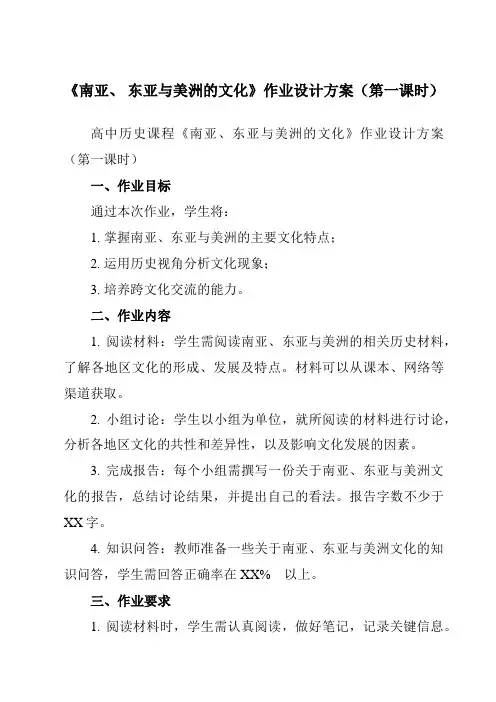
《南亚、东亚与美洲的文化》作业设计方案(第一课时)高中历史课程《南亚、东亚与美洲的文化》作业设计方案(第一课时)一、作业目标通过本次作业,学生将:1. 掌握南亚、东亚与美洲的主要文化特点;2. 运用历史视角分析文化现象;3. 培养跨文化交流的能力。
二、作业内容1. 阅读材料:学生需阅读南亚、东亚与美洲的相关历史材料,了解各地区文化的形成、发展及特点。
材料可以从课本、网络等渠道获取。
2. 小组讨论:学生以小组为单位,就所阅读的材料进行讨论,分析各地区文化的共性和差异性,以及影响文化发展的因素。
3. 完成报告:每个小组需撰写一份关于南亚、东亚与美洲文化的报告,总结讨论结果,并提出自己的看法。
报告字数不少于XX字。
4. 知识问答:教师准备一些关于南亚、东亚与美洲文化的知识问答,学生需回答正确率在XX% 以上。
三、作业要求1. 阅读材料时,学生需认真阅读,做好笔记,记录关键信息。
2. 小组讨论时,学生需积极参与,尊重他人观点,共同探讨。
3. 报告撰写时,学生需客观真实地总结讨论结果,并提出自己的看法,字数不少于300字。
4. 知识问答时,学生需认真听题,准确回答。
四、作业评价本次作业的评价将根据学生的完成情况、讨论表现、报告质量和回答正确率进行综合评价。
评价结果将作为期末总评的一部分,以激励学生的学习积极性。
五、作业反馈学生需在课后将作业提交给教师,教师将在课堂上对作业进行反馈,对于存在的问题和不足,教师将给予指导和建议。
同时,教师也将对作业中的亮点和优点给予肯定和表扬,以激发学生的自信心和学习动力。
在南亚、东亚与美洲的文化作业中,学生将有机会更深入地了解不同地区的文化特点,培养自己的历史视角和分析能力。
通过小组讨论和知识问答等形式,学生将能够锻炼自己的团队合作能力和解决问题的能力。
最终,学生将能够更好地适应全球化背景下跨文化交流的需求。
作业设计方案(第二课时)高中历史课程《南亚、东亚与美洲的文化》作业设计方案(第二课时)一、作业目标1. 通过对南亚、东亚与美洲文化的深入学习,学生能够理解不同地区文化的多样性。
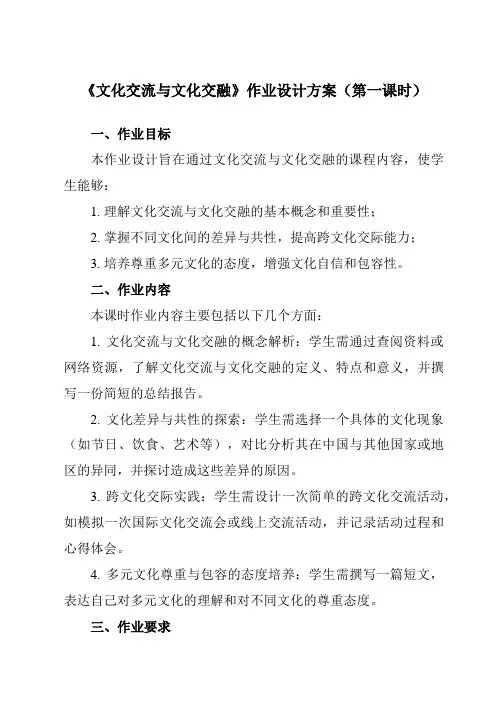
《文化交流与文化交融》作业设计方案(第一课时)一、作业目标本作业设计旨在通过文化交流与文化交融的课程内容,使学生能够:1. 理解文化交流与文化交融的基本概念和重要性;2. 掌握不同文化间的差异与共性,提高跨文化交际能力;3. 培养尊重多元文化的态度,增强文化自信和包容性。
二、作业内容本课时作业内容主要包括以下几个方面:1. 文化交流与文化交融的概念解析:学生需通过查阅资料或网络资源,了解文化交流与文化交融的定义、特点和意义,并撰写一份简短的总结报告。
2. 文化差异与共性的探索:学生需选择一个具体的文化现象(如节日、饮食、艺术等),对比分析其在中国与其他国家或地区的异同,并探讨造成这些差异的原因。
3. 跨文化交际实践:学生需设计一次简单的跨文化交流活动,如模拟一次国际文化交流会或线上交流活动,并记录活动过程和心得体会。
4. 多元文化尊重与包容的态度培养:学生需撰写一篇短文,表达自己对多元文化的理解和对不同文化的尊重态度。
三、作业要求1. 学生需独立完成作业,不得抄袭他人作品;2. 报告和分析需结合具体实例,内容要充实、逻辑清晰;3. 跨文化交际实践部分需真实记录活动过程,心得体会要真实、具体;4. 短文应不少于800字,观点明确,语言流畅,体现出对多元文化的理解和尊重。
四、作业评价1. 教师将根据学生的作业完成情况,从内容、结构、逻辑、语言等方面进行评价;2. 评价标准包括对文化交流与文化交融的理解深度、分析的准确性、实践活动的创新性和真实度、短文的观点表达和语言运用等;3. 教师将给予优秀作业以表扬和鼓励,对存在问题的地方给予指导和建议。
五、作业反馈1. 教师将在课堂上对作业进行讲评,指出普遍存在的问题和不足,分享优秀作业的亮点;2. 学生之间也可进行互评,互相学习、互相借鉴;3. 教师将根据学生作业情况,调整后续教学策略和方法,以提高教学效果。
本作业设计旨在通过系统的作业内容,帮助学生深入理解文化交流与文化交融的重要性,提高跨文化交际能力,培养尊重多元文化的态度。
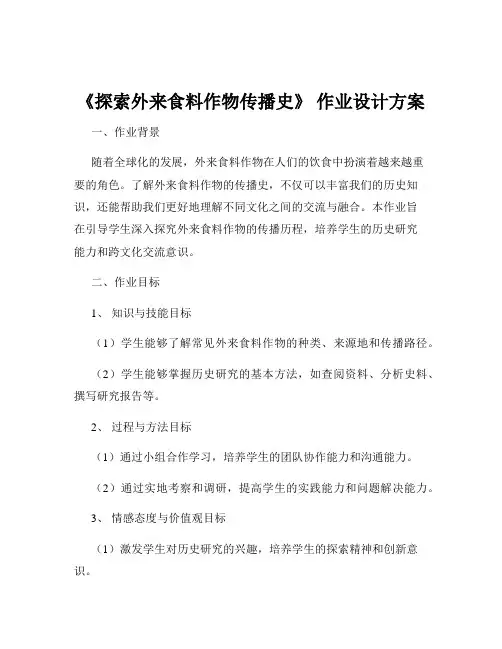
《探索外来食料作物传播史》作业设计方案一、作业背景随着全球化的发展,外来食料作物在人们的饮食中扮演着越来越重要的角色。
了解外来食料作物的传播史,不仅可以丰富我们的历史知识,还能帮助我们更好地理解不同文化之间的交流与融合。
本作业旨在引导学生深入探究外来食料作物的传播历程,培养学生的历史研究能力和跨文化交流意识。
二、作业目标1、知识与技能目标(1)学生能够了解常见外来食料作物的种类、来源地和传播路径。
(2)学生能够掌握历史研究的基本方法,如查阅资料、分析史料、撰写研究报告等。
2、过程与方法目标(1)通过小组合作学习,培养学生的团队协作能力和沟通能力。
(2)通过实地考察和调研,提高学生的实践能力和问题解决能力。
3、情感态度与价值观目标(1)激发学生对历史研究的兴趣,培养学生的探索精神和创新意识。
(2)增强学生对不同文化的尊重和理解,培养学生的全球视野和文化包容意识。
三、作业内容1、知识储备(1)教师讲解外来食料作物的概念和范畴,介绍常见的外来食料作物,如玉米、马铃薯、番茄、辣椒等。
(2)学生通过阅读教材、查阅相关资料,了解这些外来食料作物的基本特点和营养价值。
2、资料收集(1)学生分组,每组选择一种外来食料作物作为研究对象。
(2)通过图书馆、互联网等渠道,收集该作物的起源地、传播时间、传播路径、传播原因等方面的资料。
(3)对收集到的资料进行整理和分析,筛选出有价值的信息。
3、实地考察(1)组织学生到当地的农贸市场、超市或农田,观察和了解所选外来食料作物的种植、销售和消费情况。
(2)采访当地的农民、商贩或消费者,了解他们对外来食料作物的看法和使用经验。
4、撰写研究报告(1)学生根据收集到的资料和实地考察的结果,撰写关于所选外来食料作物传播史的研究报告。
(2)研究报告应包括作物的基本信息、传播历程、对当地饮食文化的影响等方面的内容,要求观点明确、论据充分、条理清晰。
5、成果展示与交流(1)每个小组推选一名代表,在课堂上展示本小组的研究成果。
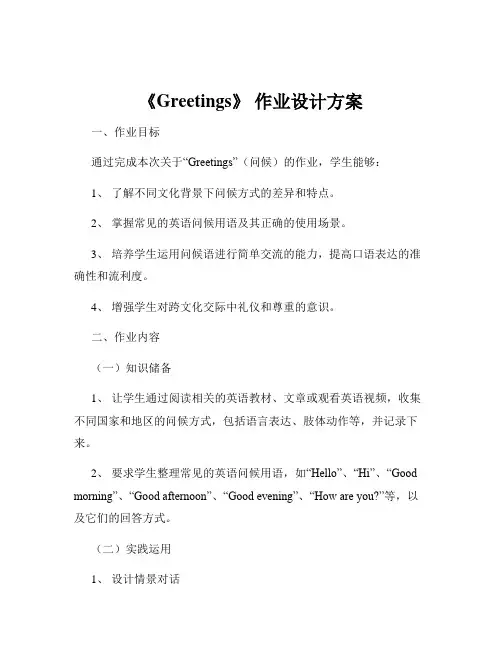
《Greetings》作业设计方案一、作业目标通过完成本次关于“Greetings”(问候)的作业,学生能够:1、了解不同文化背景下问候方式的差异和特点。
2、掌握常见的英语问候用语及其正确的使用场景。
3、培养学生运用问候语进行简单交流的能力,提高口语表达的准确性和流利度。
4、增强学生对跨文化交际中礼仪和尊重的意识。
二、作业内容(一)知识储备1、让学生通过阅读相关的英语教材、文章或观看英语视频,收集不同国家和地区的问候方式,包括语言表达、肢体动作等,并记录下来。
2、要求学生整理常见的英语问候用语,如“Hello”、“Hi”、“Good morning”、“Good afternoon”、“Good evening”、“How are you?”等,以及它们的回答方式。
(二)实践运用1、设计情景对话创设不同的场景,如学校、商店、机场等,让学生根据场景编写问候的对话,要求使用至少三种不同的问候用语。
例如:在学校场景中,学生 A 遇到学生 B,可以这样对话:A: Hi, B How are you today?B: I'm fine, thank you And how about you?A: Great! Let's go to the classroom together2、角色扮演学生分组进行角色扮演活动,模拟真实的交际场景,运用所学的问候知识进行交流。
每组学生选择一个场景,如餐厅、医院、办公室等,分配角色并进行表演。
(三)拓展延伸1、文化探究让学生探究问候方式背后的文化内涵,如为什么在某些国家人们见面时会亲吻脸颊,而在另一些国家则握手等。
学生可以通过查阅资料、访问相关网站或与外教交流等方式完成探究,并以书面报告的形式呈现。
2、创意表达鼓励学生发挥创意,设计自己独特的问候方式,可以是结合了不同文化元素的,也可以是完全创新的。
学生以图画、文字或视频的形式展示他们设计的问候方式,并解释其含义和适用场景。
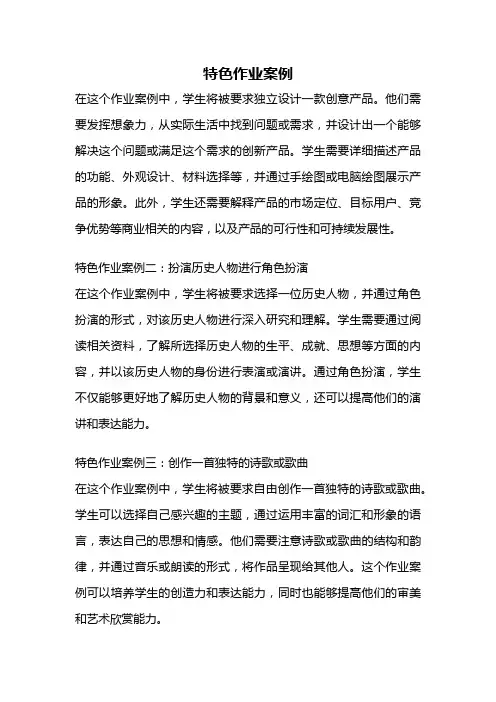
特色作业案例在这个作业案例中,学生将被要求独立设计一款创意产品。
他们需要发挥想象力,从实际生活中找到问题或需求,并设计出一个能够解决这个问题或满足这个需求的创新产品。
学生需要详细描述产品的功能、外观设计、材料选择等,并通过手绘图或电脑绘图展示产品的形象。
此外,学生还需要解释产品的市场定位、目标用户、竞争优势等商业相关的内容,以及产品的可行性和可持续发展性。
特色作业案例二:扮演历史人物进行角色扮演在这个作业案例中,学生将被要求选择一位历史人物,并通过角色扮演的形式,对该历史人物进行深入研究和理解。
学生需要通过阅读相关资料,了解所选择历史人物的生平、成就、思想等方面的内容,并以该历史人物的身份进行表演或演讲。
通过角色扮演,学生不仅能够更好地了解历史人物的背景和意义,还可以提高他们的演讲和表达能力。
特色作业案例三:创作一首独特的诗歌或歌曲在这个作业案例中,学生将被要求自由创作一首独特的诗歌或歌曲。
学生可以选择自己感兴趣的主题,通过运用丰富的词汇和形象的语言,表达自己的思想和情感。
他们需要注意诗歌或歌曲的结构和韵律,并通过音乐或朗读的形式,将作品呈现给其他人。
这个作业案例可以培养学生的创造力和表达能力,同时也能够提高他们的审美和艺术欣赏能力。
特色作业案例四:设计一个社区服务项目在这个作业案例中,学生将被要求设计一个社区服务项目,旨在解决当地社区的问题或需求。
学生需要进行实地调研,了解社区的现状和需求,然后提出一个切实可行的服务项目,并详细描述该项目的目标、实施方案、预算等内容。
学生还需要考虑项目的可持续性和社会影响,并通过口头或书面的形式,向班级或学校展示他们的设计方案。
特色作业案例五:组织一场文化活动在这个作业案例中,学生将被要求组织一场文化活动,旨在推广和传承特定的文化传统或价值观。
学生可以选择自己感兴趣的主题,如传统音乐、舞蹈、绘画、手工艺等,然后制定活动计划,包括活动内容、参与人员、场地布置等。
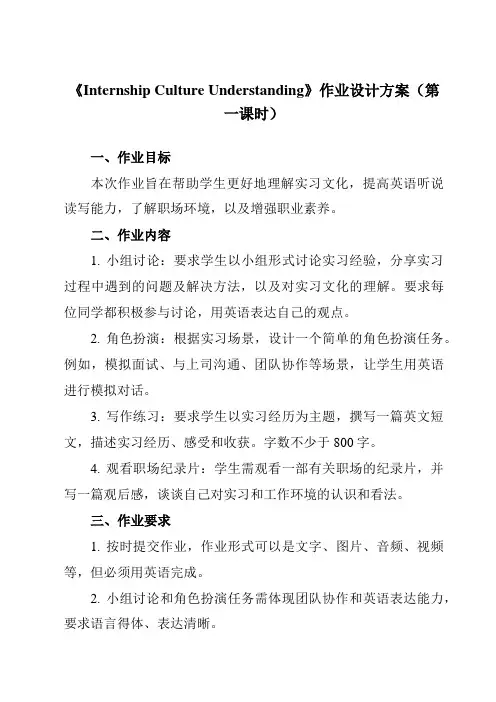
《Internship Culture Understanding》作业设计方案(第一课时)一、作业目标本次作业旨在帮助学生更好地理解实习文化,提高英语听说读写能力,了解职场环境,以及增强职业素养。
二、作业内容1. 小组讨论:要求学生以小组形式讨论实习经验,分享实习过程中遇到的问题及解决方法,以及对实习文化的理解。
要求每位同学都积极参与讨论,用英语表达自己的观点。
2. 角色扮演:根据实习场景,设计一个简单的角色扮演任务。
例如,模拟面试、与上司沟通、团队协作等场景,让学生用英语进行模拟对话。
3. 写作练习:要求学生以实习经历为主题,撰写一篇英文短文,描述实习经历、感受和收获。
字数不少于800字。
4. 观看职场纪录片:学生需观看一部有关职场的纪录片,并写一篇观后感,谈谈自己对实习和工作环境的认识和看法。
三、作业要求1. 按时提交作业,作业形式可以是文字、图片、音频、视频等,但必须用英语完成。
2. 小组讨论和角色扮演任务需体现团队协作和英语表达能力,要求语言得体、表达清晰。
3. 写作练习需真实反映实习经历,语法正确、表达流畅。
4. 观后感需结合纪录片内容,深入思考职场文化,字数不少于1000字。
5. 作业需按时提交,逾期不候。
四、作业评价1. 评价标准:作业完成质量、团队协作表现、英语表达能力等方面进行评价。
2. 评价方式:教师评价和学生互评相结合,综合评价学生作业表现。
五、作业反馈教师将对学生的作业进行批改,并在课堂上进行反馈。
对于优秀的作业,将给予表扬和鼓励;对于存在问题的作业,将指出问题所在并提供改进建议。
同时,教师也将收集学生的反馈意见,以便更好地改进教学。
具体作业内容如下:1. 小组讨论:请同学们以小组形式讨论实习经验,分享实习过程中遇到的问题及解决方法,以及对实习文化的理解。
每组需要选出一位代表,用英语总结小组讨论的成果。
2. 角色扮演:请同学们根据提供的场景,用英语模拟面试、与上司沟通、团队协作等场景。
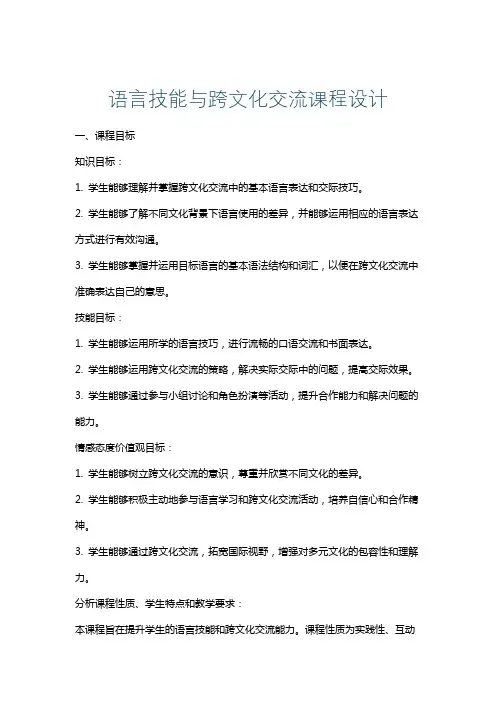
语言技能与跨文化交流课程设计一、课程目标知识目标:1. 学生能够理解并掌握跨文化交流中的基本语言表达和交际技巧。
2. 学生能够了解不同文化背景下语言使用的差异,并能够运用相应的语言表达方式进行有效沟通。
3. 学生能够掌握并运用目标语言的基本语法结构和词汇,以便在跨文化交流中准确表达自己的意思。
技能目标:1. 学生能够运用所学的语言技巧,进行流畅的口语交流和书面表达。
2. 学生能够运用跨文化交流的策略,解决实际交际中的问题,提高交际效果。
3. 学生能够通过参与小组讨论和角色扮演等活动,提升合作能力和解决问题的能力。
情感态度价值观目标:1. 学生能够树立跨文化交流的意识,尊重并欣赏不同文化的差异。
2. 学生能够积极主动地参与语言学习和跨文化交流活动,培养自信心和合作精神。
3. 学生能够通过跨文化交流,拓宽国际视野,增强对多元文化的包容性和理解力。
分析课程性质、学生特点和教学要求:本课程旨在提升学生的语言技能和跨文化交流能力。
课程性质为实践性、互动性强的学科。
学生处于青少年阶段,好奇心强,善于模仿,对跨文化交际有较高的兴趣。
教学要求注重培养学生在实际情境中的语言运用能力,强调学生的主动参与和合作学习。
根据以上分析,课程目标分解为具体学习成果:1. 学生能够运用所学语言知识,进行模拟跨文化交际活动,并达到准确、流畅的表达。
2. 学生能够在小组合作中,运用跨文化交流策略,解决设定的问题情境。
3. 学生能够以积极的态度参与课堂活动,展示对文化差异的尊重和包容。
二、教学内容本课程教学内容紧密结合课程目标,依据教材相关章节进行选择和组织,确保科学性和系统性。
1. 语言表达与交际技巧:- 教材章节:第一单元“口语表达技巧”和第二单元“书面表达技巧”- 内容:基本语音、语调训练,日常会话表达,书信、电子邮件写作等。
2. 文化差异与语言运用:- 教材章节:第三单元“文化差异与交际”- 内容:不同文化背景下的交际礼仪,语言使用习惯,非言语交际等。
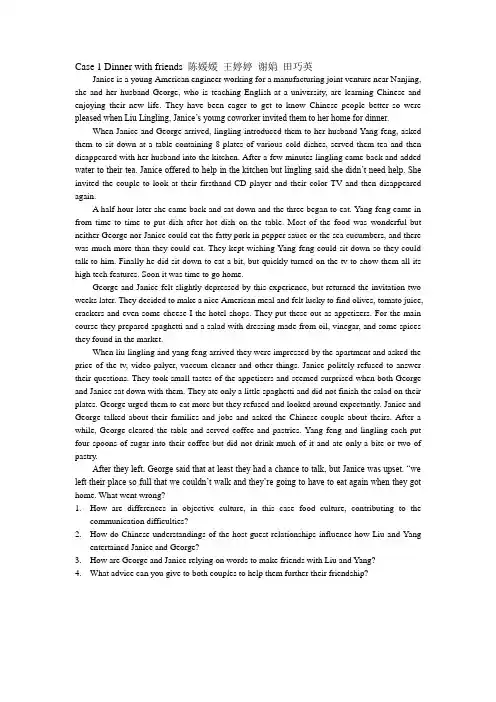
Case 1 Dinner with friends 陈媛媛王婷婷谢娟田巧英Janice is a young American engineer working for a manufacturing joint venture near Nanjing, she and her husband George, who is teaching English at a university, are learning Chinese and enjoying their new life. They have been eager to get to know Chinese people better so were pleased when Liu Lingling, Janice’s young coworker invited them to her home for dinner.When Janice and George arrived, lingling introduced them to her husband Yang feng, asked them to sit down at a table containing 8 plates of various cold dishes, served them tea and then disappeared with her husband into the kitchen. After a few minutes lingling came back and added water to their tea. Janice offered to help in the kitchen but lingling said she didn’t need help. She invited the couple to look at their firsthand CD player and their color TV and then disappeared again.A half-hour later she came back and sat down and the three began to eat. Yang feng came in from time to time to put dish after hot dish on the table. Most of the food was wonderful but neither George nor Janice could eat the fatty pork in pepper sauce or the sea cucumbers, and there was much more than they could eat. They kept wishing Yang feng could sit down so they could talk to him. Finally he did sit down to eat a bit, but quickly turned on the tv to show them all its high tech features. Soon it was time to go home.George and Janice felt slightly depressed by this experience, but returned the invitation two weeks later. They decided to make a nice American meal and felt lucky to find olives, tomato juice, crackers and even some cheese I the hotel shops. They put these out as appetizers. For the main course they prepared spaghetti and a salad with dressing made from oil, vinegar, and some spices they found in the market.When liu lingling and yang feng arrived they were impressed by the apartment and asked the price of the tv, video palyer, vaccum cleaner and other things. Janice politely refused to answer their questions. They took small tastes of the appetizers and seemed surprised when both George and Janice sat down with them. They ate only a little spaghetti and did not finish the salad on their plates. George urged them to eat more but they refused and looked around expectantly. Janice and George talked about their families and jobs and asked the Chinese couple about theirs. After a while, George cleared the table and served coffee and pastries. Yang feng and lingling each put four spoons of sugar into their coffee but did not drink much of it and ate only a bite or two of pastry.After they left, George said that at least they had a chance to talk, but Janice was upset. “we left their place so full that we couldn’t walk and they’re going to have to eat again when they got home. What went wrong?1.How are differences in objective culture, in this case food culture, contributing to thecommunication difficulties?2.How do Chinese understandings of the host-guest relationships influence how Liu and Yangentertained Janice and George?3.How are George and Janice relying on words to make friends with Liu and Yang?4.What advice can you give to both couples to help them further their friendship?Case 2 Finding an interested buyer 唐小涵谢昕汝李冬梅George Hall was in Beijing attending a trade fair and looking for an opportunity to do business in China. He had been very successful in his business dealings in the US and prided himself on his ability “to get things moving”. His first day was going well. He looked around at the displays of sporting equipment to get some idea of whom he might approach. He was sure that his productive, tennis rickets with an unusual new design, would arouse some interest. On the second ascendancy he approached the company which he felt would be most responsive to his products. He introduced himself to the general manager, a Mr. Li. Since he had read that Chinese find getting down to business immediately too abrupt and rude, he began a casual conversation, eventually leading up to the topic of his products and suggesting how Mr. Li’s company might benefit from using them. George then suggested that he could arrange to get together with Mr. Li and provide more specifics and documentation on his products.Mr. Li responded in fairly good English, “That would be interesting”.Knowing that he had only a few days left in Beijing, George wanted to nail down a time. “When can we meet?” asked George.“Ah. This week is very busy,” replied Mr. Li“It sure is,” said George, “How about 10 o’clock? Meet you here.”“Tomorrow at 10 o’clock?” asked Mr. Li thoughtfully.“Right”, said George, “I’ll see you then?”“Hmm, yes; why don’t you come by tomorrow,” was the reply.“OK”, responded George, “It was nice meeting you.”The next day at 10 o’clock he approached Mr. Li’s company’s exhibit only to find that Mr. Li had some important business and was not able to meet with George. He called back later in the day and was told that Mr. Li was not available.1.What expectations does each of these men have about the formality of a firstbusiness contact?2.What should George have not iced about Mr. Li’s responses to his suggestion for ameeting? Use the concept of high and low context communication in your explanation.3.What advice would you give to each of the two men about how to avoid makingthe same mistakes the next time one of them is in a similar situation?Case 3 What is true friendship? 邓琳琳韩娇淳子祎唐竹Yang ruifang worked as a secretary in an Australian company in Melbourne. She became friendly with one of the Australian secretaries, a woman named Cathy Lane. The two usually ate lunch together and Yang often asked Cathy for advice on problems she faced adjusting to Australian society. Cathy gave her a lot of advice and helped her move from one apartment to another. Cathy went with Yang to the Immigration Bureau several times to help sort out some problems. Yang visited Cathy several times at home but did not invite Cathy to her apartment because she shared it with four other people. If they did not see each other over the weekend, they usually talked on the telephone. As Yang was also preparing to take an English test, she was able to get a lot of help with English in this way.However, something seemed to be going wrong, Cathy seemed to be getting impatient, even a little cold. She started going out by herself at lunchtime instead of eating with Yang, and seemed reluctant to answer questions. Yang was puzzled. She couldn’t imagine what the problem was.1.What was Yang doing that made Cathy decide that the relationship was not a truefriendship?2.Why did Yang think the relationship was developing well?3.From this case what do you think Australians and other westerners expect fromtheir friends?4.Give advice to Cathy and Yang to help them restore their friendship.Case 4 How do students learn? 张秋生徐海郑世贵Karen had been teaching high school English in the United States before she accepted a teaching job at a teacher’s college in china. She found her new environment and her new teaching assignment exciting. Both her students and her colleagues seemed a bit shy of her, but Karen was sure that in time they would all come to be friends.In the classroom, however, Karen was very frustrated. When she asked a question, the class was silent. Only if she called on a particular student would she get an answer, often a very good one. She could not understand why they wouldn’t volunteer when they obviously knew the answers. They were very quiet when she was speaking in front of the class, and never asked questions, let alone interrupt with an opinion, but as soon as the class ended, they would cluster around her desk to ask their questions one-by-one. They would also offer their suggestions about the lesson at this time. Karen often asked her students to work in small groups during class, especially when they were editing each other’s writing. They were slow to move into groups and when they did, they often simply formed a group with the people sitting next to them. Finally she devised her own system of forming groups to get them to interact with students sitting in another section of the classroom.Most frustrating of all, after she taught her class how to edit essays, she found that the students were likely to write vague and not very helpful remarks on their classmates’ papers. They would say nice things about the essays and correct small grammatical errors, but seemed unwilling to criticize them in a way that would help another student revise the essay. They usually accepted her criticism of their writing with good spirits and promises to improve. In fact they frequently asked for more correction of their English from her than she wanted to give. She felt that one hundred percent grammatical correctness was not as important as learning how to correct what they had written on their own and with the help of others. After all, they would not always have a teacher to tell them what was good and not so good about their English writing.1.Explain why students are behaving in the way she experiences as a problem.2.What do you appreciate about the traditional Chinese way of learning and what doyou appreciate about the way learning some foreign teachers prefer?3.What do foreign teachers do in class that make Chinese students uncomfortable?。
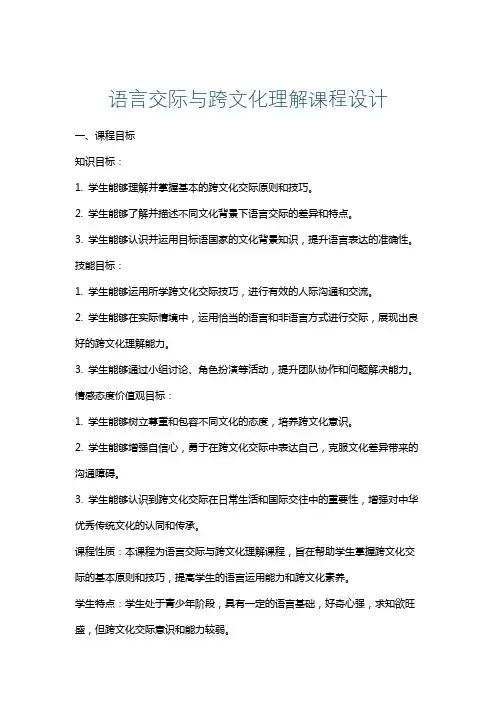
语言交际与跨文化理解课程设计一、课程目标知识目标:1. 学生能够理解并掌握基本的跨文化交际原则和技巧。
2. 学生能够了解并描述不同文化背景下语言交际的差异和特点。
3. 学生能够认识并运用目标语国家的文化背景知识,提升语言表达的准确性。
技能目标:1. 学生能够运用所学跨文化交际技巧,进行有效的人际沟通和交流。
2. 学生能够在实际情境中,运用恰当的语言和非语言方式进行交际,展现出良好的跨文化理解能力。
3. 学生能够通过小组讨论、角色扮演等活动,提升团队协作和问题解决能力。
情感态度价值观目标:1. 学生能够树立尊重和包容不同文化的态度,培养跨文化意识。
2. 学生能够增强自信心,勇于在跨文化交际中表达自己,克服文化差异带来的沟通障碍。
3. 学生能够认识到跨文化交际在日常生活和国际交往中的重要性,增强对中华优秀传统文化的认同和传承。
课程性质:本课程为语言交际与跨文化理解课程,旨在帮助学生掌握跨文化交际的基本原则和技巧,提高学生的语言运用能力和跨文化素养。
学生特点:学生处于青少年阶段,具有一定的语言基础,好奇心强,求知欲旺盛,但跨文化交际意识和能力较弱。
教学要求:教师应结合课本内容,设计丰富多样的教学活动,激发学生的学习兴趣,引导学生主动参与,注重培养学生的实践能力和综合素质。
同时,关注学生的个体差异,提供有针对性的指导,确保课程目标的实现。
通过本课程的学习,使学生能够具备一定的跨文化交际能力,为未来的国际交往打下坚实基础。
二、教学内容本课程以《英语》教材中关于跨文化交际的相关章节为基础,结合以下教学内容,确保课程的科学性和系统性:1. 跨文化交际基本概念:介绍跨文化交际的定义、重要性及影响因素,让学生对跨文化交际有初步的认识。
2. 跨文化交际原则:学习并掌握尊重、开放、包容、理解等跨文化交际的基本原则,提高学生的跨文化素养。
3. 语言交际差异:分析英汉语言在表达方式、语境、语用等方面的差异,使学生能够更好地运用语言进行有效交际。
Chapter 5 Verbal Intercultural Communication Part I questions Case 25 1. What kind of information did Mary expect to get from Goshima? Why is Mary disappointed? Mary expected to hearing about Goshima’s experiences and her greatest success stories. Mary disappointed because Goshima always says she was learned a lot from her colleagues. She never says anything about her own which Mary means her success story.
2. How do the verbal communication styles of Mary and Goshima differ? Goshima’s verbal communication style is quite reticent and self-effacement. Mary’s is direct.
Text A 1. What does “verbal” mean? What does verbal intercultural communication mean? “Verbal” means “consisting of words”. Language, spoken or written, is a means of verbal communication. Verbal intercultural communication happens when people from different cultural backgroungs communicate with each other by using language.
Text B 1. What is the Sapir-Whorf hypothesis about language and culture? The hypothesis holds that the structure of a language affects the perceptions of reality of its speakers and thus influences their thought patterns and worldviews. Language structure controls thoughts and cultural norms. Culture is controlled by and controls languages.
Text C 1. What are the differences between direct and indirect verbal communication styles? Explain with examples. The direct and indirect styles differ in the extent to which communicators reveal their intentions through their tone of voice and the straightforwardness of their message. In the direct verbal styles, statements clearly reveal the speaker’s intentions. In the indirect verbal style, verbal statements tend to hide the speaker’s actual intentions. For example, in a verbal request situation, Americans tend to use a straightforward form of request whereas Chinese tend to ask for a favor in a more roundabout and implicit way.
2. What are the differences between self-enhancement and self-effacement verbal communication styles? Explain with examples. The self-enhancement verbal style emphasizes the importance of boasting about one’s accomplishments and abilities. The self-effacement verbal style emphasizes the importance of humbling oneself via verbal restraints, hesitations and modest talk. For example, Japanese, when serving tea, tend to say, “this is not very delicious, but…” In America, people will say “this is the best I can offer.” 3. What are the differences among elaborate, exacting, and succinct verbal communication styles? Explain with examples. An elaborate style emphasizes flashy and embellished language. People prefer personalized, often exaggerated styles of interaction. An exacting style, people prefer an exacting style of interaction consistent with a “just the facts” mentality. A succinct style is characterized by the use of concise statements, understatements, and even silence. E.g. when people say the same thing, people in Arab may say it with many metaphors, similes and adjectives in the conversation. An American may just say “just the facts!” a Chinese may say “silence is golden!”
4. What are the differences between personal and contextual verbal communication styles? Explain with examples. Personal verbal communication style emphasizes the individual identity of the speaker. It relies on the use of pronouns in sentence construction. E.g. English has only one form for the second person that is you. A contextual style highlights one’s role identity and status. In cultures that employ a contextual style, the social context dictates word choice, especially personal pronouns. For examples, when using that language, one must look carefully at the situation, including the status and intimacy level among the interactions, in order to decide what form of pronoun to use.
5. What are the differences between instrumental and affective verbal communication styles? Explain with examples. An instrumental verbal style is sender-based and goal-outcome based. The instrumental speaker uses communication to achieve some goal or outcome. An affective communication style is receiver and process oriented. The affective speaker is concerned not so much with the outcome of the communication, but with the process. E.g.: Chinese people reject debate and argumentation during the process of communication.
6. What verbal communication styles do Chinese use? Chinese use affective styles, because Chinese view communication as an interdependent process whereby both speaker and listener are active participants who, together, create meaning.